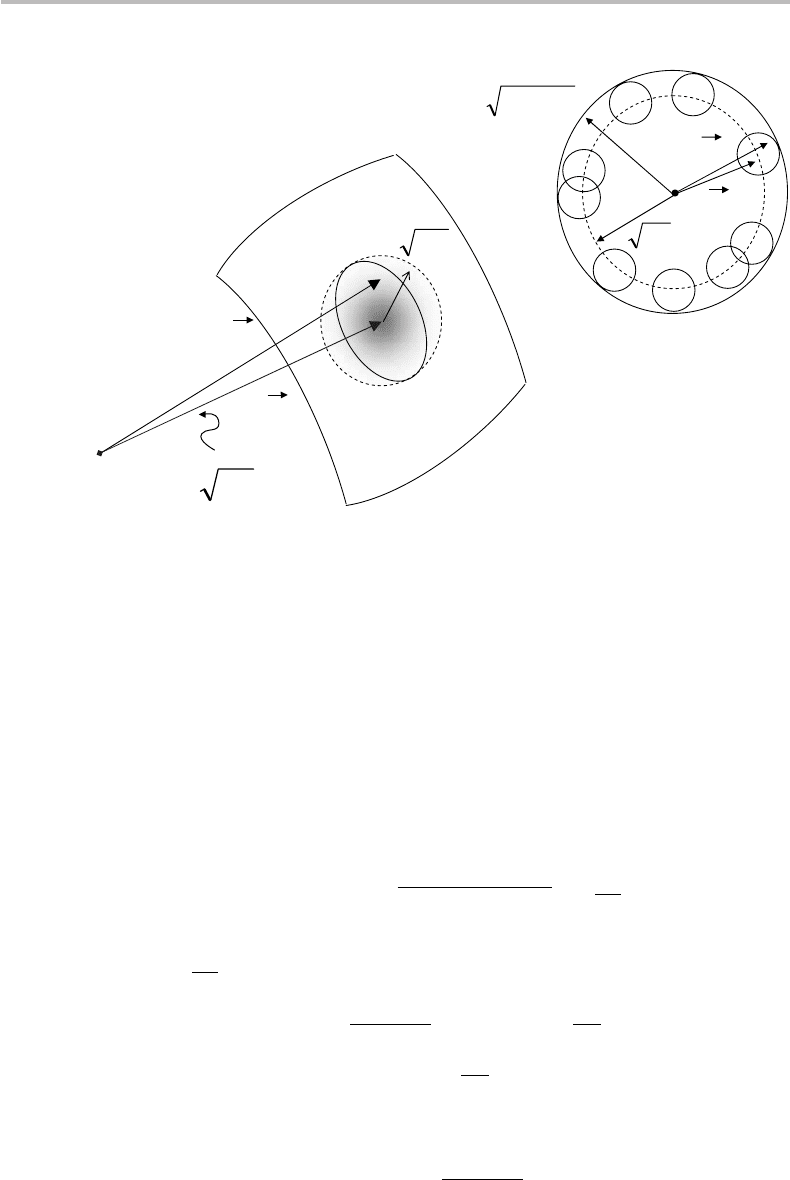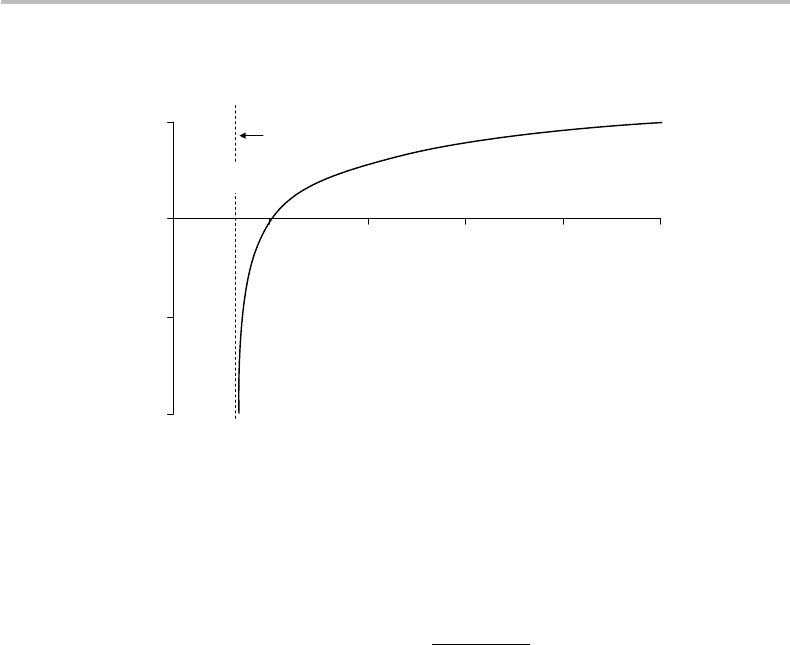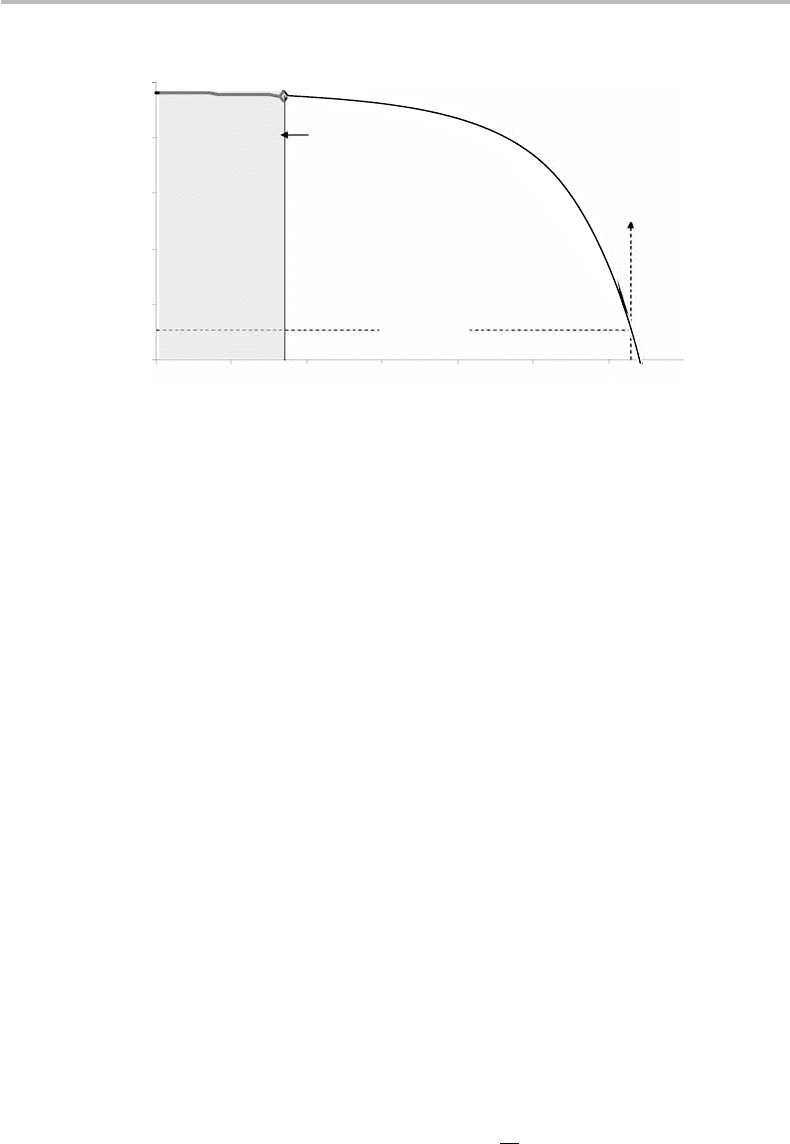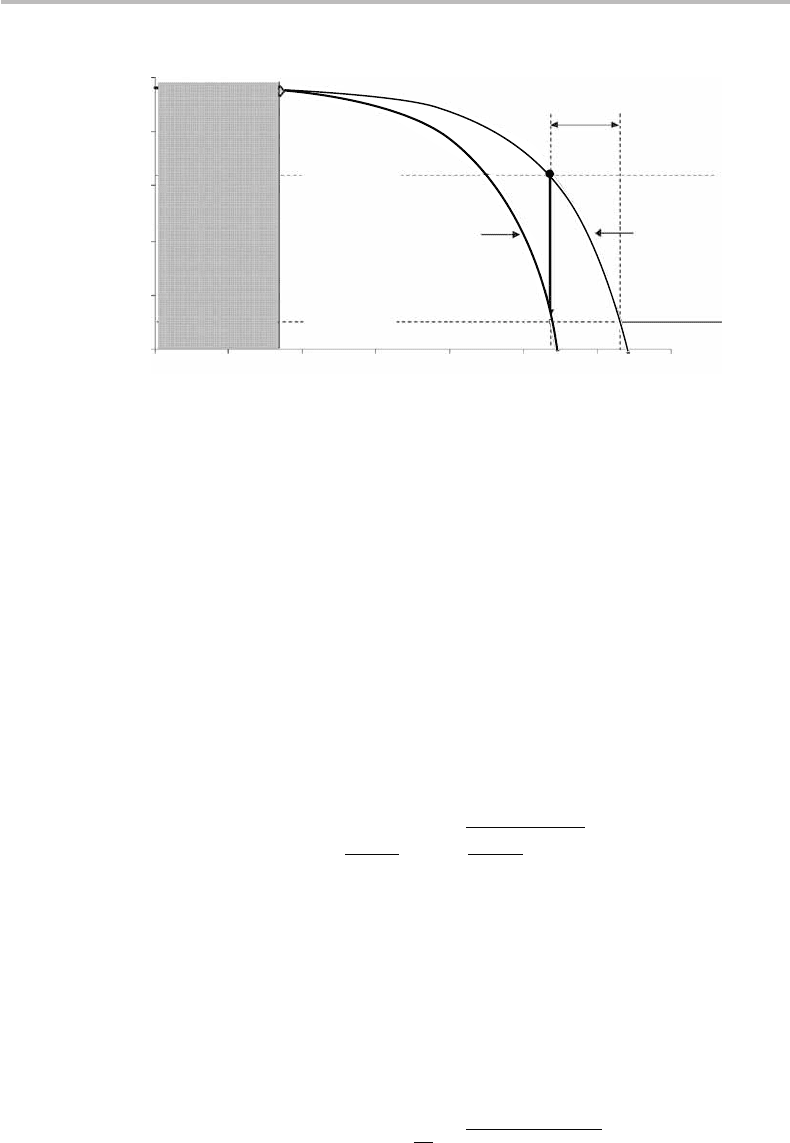Desurvire E. Classical and Quantum Information Theory: An Introduction for the Telecom Scientist
Подождите немного. Документ загружается.


14.1 Gaussian channel 267
y at the output given that x is the input is p(y|x) = p(z). Substituting this property in
the definition of conditional entropy H(Y |X ), we obtain:
H(Y |X ) =−
j
i
p(x
i
, y
i
)logp(y
j
|x
i
)
=−
j
i
p(y
j
)p(y
j
|x
i
)logp(y
j
|x
i
)
=−
j
i
p(y
j
)p(z
i
)logp(z
i
) (14.9)
=−
j
p(y
j
)
i
p(z
i
)logp(z
i
)
= H (Z)
= log
(
2πeσ
2
ch
.
As previously stated, the same result as in Eq. (14.9) can be obtained using the differential
or continuous definition of conditional entropy, i.e., to recall from Chapter 6:
H(Y |X ) =−
p(y|x) p(x)logp(y|x)dxdy. (14.10)
The computation of the double integral in Eq. (14.10) is elementary, albeit relatively
tedious to carry out, so we shall leave it here as a “math” exercise.
We consider next the capacity of the Gaussian channel. By definition, the channel
capacity C is given by the maximum of the mutual information H (X; Y ) = H (Y ) −
H(Y |X ). Using the previous results in Eqs. (14.6) and (14.7)forH (Y ) and H (Y |X) =
H(Z ), we obtain:
H(X ; Y ) = H(Y ) − H(Y |X ) = H (Y ) − H(Z )
=
1
2
log
πeσ
2
out
−
1
2
log
2πeσ
2
ch
=
1
2
log
2
σ
2
out
σ
2
ch
=
1
2
log
2
σ
2
in
+ σ
2
ch
σ
2
ch
,
(14.11)
and using σ
2
out
= σ
2
in
+ σ
2
ch
, σ
2
in
= P, σ
2
ch
= N :
H(X ; Y ) =
1
2
log
2
1 +
P
N
. (14.12)
The mutual information H (X ; Y ) defined in Eq. (14.12) also corresponds to the channel
capacity C. This is because (given the signal power constraint P) the Gaussian distribu-
tion maximizes the source entropies H (X )orH(Y ), making H (X; Y ) an upper bound
for mutual information. Thus, we can write, equivalently:
C =
1
2
log
2
1 +
P
N
. (14.13)
In the above, the quantity P/N is called the signal-to-noise ratio, or SNR. The funda-
mental result in Eq. (14.13), which establishes that the capacity of a “noisy channel”
is proportional to log(1 + SNR) is probably the most well known and encompassing

268 Gaussian channel and Shannon–Hartley theorem
nP
x
nN
y
Hypersphere surface
x
y
(a)
(b)
nP
n
(
P
+
N
)
Figure 14.1 (a) Location of input message x, defined by vector x, and likely location of output
message y, defined by vector y, on the surface of a hypersphere of dimension n; (b) as (a), but
for n = 2.
conclusion of all Shannon’s information theory. Given the SNR characteristics of a com-
munication channel with noise and signal power limitation, it provides an upper bound
for the code rate at which information can be transmitted with arbitrarily small errors.
Before expanding on the implications of this result for communication systems, it is
worth providing a plausibility argument for the existence of the corresponding codes
with low error probability. The argument immediately following can be found with
different variants in most IT textbooks.
Consider an input message (or codeword) consisting of a sequence of n discrete
waveform samples with random amplitudes x
i
of zero mean and mean power x
2
i
=P.
This message defines a vector x = (x
1
, x
2
,...,x
n
)inann-dimensional space, which
is characterized by a length | x|=
(
x
2
1
+ x
2
2
+···+x
2
n
=
√
nP. Thus, we can view
the input message as lying on any point x = (x
1
, x
2
,...,x
n
), which is most probably
located close to the surface of a hypersphere centered about the origin and having a
radius of
√
nP. Likewise, the received or output message corresponds to an n-vector
y = (y
1
, y
2
,...,y
n
) with y
i
= x
i
+ z
i
, where z
i
=0 and z
2
i
=N . Thus, the output
vector y has the length | y|=
n(P + N ) with deviation
√
nN. The output message is
likely to fall on any point y = (y
1
, y
2
,...,y
n
) inside a small hypersphere centered about
x = (x
1
, x
2
,...,x
n
) and having a radius of
√
nN, as illustrated in Fig. 14.1.
For any output message y to represent nonconfusable input messages x (i.e., most
likely to correspond to a unique input message x), the small spheres should be nonin-
tersecting or disjoint. Here comes the key question: how many such disjoint spheres can
be fitted inside the hypersphere of radius
n(P + N )?

14.1 Gaussian channel 269
The answer comes as follows. The volume V
n
of a hypersphere with dimension n and
radius r is given by the formula V
n
= A
n
r
n
, with the coefficient A
n
defined by:
A
n
=
π
n/2
1 +
n
2
, (14.14)
where (m) is the gamma function.
3
The maximum number M of disjoint spheres that
can be fitted inside the volume V
n
is, thus,
M =
A
n
n(P + N )
n
A
n
√
nN
n
=
1 +
P
N
n/2
≡ 2
n
2
log
2
(1+
P
N
)
. (14.15)
The result in Eq. (14.15) shows that there exist M = 2
nR
possible messages with non-
confusable inputs, corresponding to the channel or code rate
R =
1
2
log
2
1 +
P
N
. (14.16)
Since R is the maximum rate for which the messages have nonconfusable inputs (mean-
ing that receiving and decoding errors can be made arbitrarily small), the value found
in Eq. (14.16) represents an upper bound, which corresponds to the channel capacity.
Thus, the demonstration confirms the fundamental result found in Eq. (14.13).
The unit of channel capacity is bits or, more accurately, bits per channel use.
4
Then how
does channel capacity relate to channel bandwidth? We shall now address this question
as follows. Define B as the signal bit rate. To recover bits from signal waveforms, a basic
engineering principle states that the waveform must be sampled at the Nyquist sampling
rate of f = 2B per unit time (i.e., twice the bit rate). A continuous communication
channel with a capacity C
bit
, which is used at the rate f = 2B, gives us the capacity per
unit time C
bit/s
= 2BC
bit
.
Substituting the above result into Eq. (14.13), we obtain
C
bit/s
= B log
2
1 +
P
N
. (14.17)
By dividing both sides in Eq. (14.17)byB, we obtain another definition of channel
capacity, which now has the dimensionless unit of (bit/s)/Hz:
C
(bit/s)/Hz
= log
2
1 +
P
N
. (14.18)
The results in either Eq. (14.17)orEq.(14.18) are known as the Shannon–Hartley the-
orem (SHT), based on an earlier contribution from Hartley to Shannon’s analysis (see
previously). The SHT is also referred to as the Shannon–Hartley law,theinformation
3
The gamma function has the property (m + 1) = m!, with (1/2) =
√
π, (3/2) =
√
π/2, and (m +
1/2) = (1/2)
1.3.5,...,(2m−1)
2
m
. It can readily be checked that V
n
= A
n
r
n
with the definition in Eq. (14.14)
yields V
2
= πr
2
, V
3
= (4/3)πr
3
, etc.
4
Channel capacity is conceptually similar to the capacity of transportation means. Thus, if for instance an
airplane or a truck can transport 300 passengers or 20 tons, respectively, this corresponds to capacities of
300 passengers or 20 tons per single use of the airplane or of the truck. Using these transportation means
several times does not increase the capacity per use, as was also shown in Appendix L.

270 Gaussian channel and Shannon–Hartley theorem
capacity theorem,ortheband-limited capacity theorem. To recall, SHT or its different
appellations relate to Shannon’s “second theorem” or “[noisy] channel-capacity theo-
rem.” As expressed in Eq. (14.17), the SHT provides the maximum bit rate achievable
(C
bit/s
) given the channel bandwidth, additive noise background, and signal power con-
straint, for which information can be transmitted with an arbitrarily small BER.The
SHT variant in Eq. (14.18) provides the maximum bit rate achievable per unit of band-
width (Hz), under said conditions. The bit rate normalized to bandwidth is referred to as
information spectral density, or ISD. The (bit/s)/Hz ISD, is often referred to as spectral
efficiency. This would be a correct appellation if the ISD was bounded to a maximum
of unity, corresponding to 100% efficiency, or 1 (bit/s)/Hz. However, there are a variety
of modulation formats, which make it possible to encode more than 1 bit/s in a single
Hz of frequency spectrum, as discussed further on. Regardless of the possible existence
of such modulation formats, the SHT states that the ISD is actually unbounded.In
the limit of high signal-to-noise ratios (SNR = P/N ), we find C ≈ log
2
(SNR). This
result means that every twofold increase (or 3 dB, in the decibel scale
5
) of the SNR
corresponds to an ISD increase of one additional (bit/s)/Hz. For instance, SNR = 2
10
=
1024 =+30.1 dB corresponds to an ISD of log
2
(1 + 2
10
) ≈ 10 (bit/s)/Hz. The SHT,
thus, states that given any SNR constraint, there exist some codes (and associated
modulation formats) for which error-free transmission is possible within an ISD limit
of C
(bit/s)/Hz
= log
2
(1 + SNR). As with the (discrete) channel coding theorem (Chapter
13), how to find or to design such codes is, however, not specified by the theory.
In the above SHT formulation, it is possible to introduce another important parameter
overlooked so far, which is the noise bandwidth. Assume a communication channel with
a capacity per unit time of C
bit/s
and a signal bandwidth B. The mean signal power, P,
and the mean energy per bit, E
S
, are related through P = E
S
C
bit/s
. The noise power, N ,
and the mean noise energy per bit, E
N
, are related through N = E
N
B
Hz
. Thus, the SNR
can also be expressed in the form
SNR =
P
N
=
E
S
C
bit/s
E
N
B
, (14.19)
which explicitly relates the bit SNR to the bandwidth B. Replacing the above result in
Eq. (14.17) yields
C
bit/s
= B log
2
1 +
E
S
C
bit/s
E
N
B
, (14.20)
then
C
bit/s
= log
2
1 +
E
S
E
N
C
(bit/s)/Hz
. (14.21)
5
For any nonnegative real number q
linear
, the decibel scale is defined as q
dB
= 10 log
10
(q
linear
). For instance,
20 dB = 100
linear
, −10 dB = 0.1
linear
, and, in particular, 3.0102 dB ≈ 3dB= 2
linear
.

14.1 Gaussian channel 271
0 5 10 15 20
SNR
bit
(dB)
ISD ((Bit/s)/Hz)
0.01
0.1
−5
1
10
−1.6 dB
R
=
C
R
>
C
R
<
C
Shannon limit
Figure 14.2 Bandwidth-efficiency diagram plotting information spectral density (ISD) vs.
signal-to-noise ratio (bit SNR), according to Eq. (14.22). The two regions R < C and R > C,
corresponding to bit rate R and channel capacity C
bit/s
, which are separated by the capacity-
boundary curve (R = C) are also shown. The Shannon limit corresponds to SNR =−1.6 dB.
Base-two exponentiation of both sides of Eq. (14.21), and the introduction of SNR
bit
=
E
S
/E
N
as defining the bit SNR,
6
we finally obtain:
SNR
bit
=
2
C
(bit/s)/Hz
− 1
C
(bit/s)/Hz
. (14.22)
This formula now provides an explicit and universal relation between the bit SNR
(SNR
bit
) and the channel ISD (C
(bit/s)/Hz
). It is, thus, possible to plot the function
C
(bit/s)/Hz
= f (SNR
bit
), as shown in Fig. 14.2, which is referred to as the bandwidth-
efficiency diagram.
As observed from Fig. 14.2, the boundary curve C
(bit/s/Hz)
= f (SNR
bit
) defines two
regions in the plane. If R
bit/s
is the bit rate, these two regions correspond to R
bit/s
< C
bit/s
and R
bit/s
> C
bit/s
, respectively. The interpretation of the bandwidth-efficiency diagram
is then:
r
In the region R
bit/s
< C
bit/s
, there exist codes for which transmission can be achieved
with arbitrary low error (BER);
r
In the region R
bit/s
> C
bit/s
, there is no code making transmission possible at arbitrarily
low error.
To avoid any misinterpretation, it is always possible to transmit information with some
finite or nonzero BER in any location of the diagram. However, only in the lower-right
region R
bit/s
< C
bit/s
of the diagram can the BER be made arbitrarily small with a proper
code choice code, leading to arbitrarily error-free transmission.
6
The ratio SNR
bit
= E
S
/E
N
is often referred to in textbooks as E
b
/N
0
,whereE
b
= E
S
is the bit energy and
N
0
= E
N
is the noise energy or noise spectral density.

272 Gaussian channel and Shannon–Hartley theorem
We also observe from Fig. 14.2 that the boundary curve C
(bit/s)/Hz
= f (SNR
bit
) has an
asymptotic limit at SNR
bit
=−1.6 dB, which is referred to as the Shannon limit.Asthe
figure indicates, when the SNR approaches this lower bound, the ISD rapidly vanishes
to become asymptotically zero as SNR
bit
→−1.6 dB. On the right-hand side of the
boundary curve, there exist some codes for which error-free transmission is possible.
But as observed from the figure, the closer one approaches the Shannon-limit SNR, the
lower the ISD and the smaller the number of bits that can be effectively transmitted per
unit time and unit bandwidth. The limiting condition SNR
bit
=−1.6 dB corresponds to
a useless channel with an ISD of 0 (bit/s)/Hz.
The bandwidth-efficiency diagram suggests two strategies for optimizing the trans-
mission of information:
r
Horizontally, or at fixed ISD, by increasing the bit-SNR to reduce the BER;
r
Vertically, or at fixed SNR, to increase the ISD and, hence, to increase the bit rate.
At this point, we, thus, need to address two issues: (a) the relation between the waveform
modulation format and the ISD, and (b) for a given modulation format, the relation
between SNR and BER (or symbol error rate, SER, for multi-level formats). With such
knowledge, we will then be able to fill out the diagram with different families of points,
i.e., to plot iso-format or iso-SER/BER curves, and observe the corresponding tradeoffs.
An overview of the different types of modulation formats is beyond the scope of this
book. Here, we shall use a limited selection of modulation formats and their ISD, SNR,
or SER properties to provide illustrative cases of bandwidth-efficiency tradeoffs. The
following assumes some familiarity with telecommunications signaling (i.e., intensity,
frequency, phase, amplitude, and multi-level waveform modulation).
7
Nonreturn-to-zero (NRZ) format
The nonreturn-to-zero (NRZ) format, also called on–off keying (OOK), corresponds to
the most basic and common modulation scheme. Bit encoding consists of turning the
signal power on or off during each bit period, to represent 1 or 0, respectively. Its ISD is
intrinsically limited to 1 (bit/s)/Hz
8
and its BER is given by the generic formula:
BER =
1
2
erfc
3
1
2
5
SNR
bit
2
4
, (14.23)
where erf(x)isthecomplementary error function.
9
7
S. Haykin, Digital Communications (New York: J. Wiley & Sons, 1988), J. G. Proakis, Digital Communica-
tions, 4th edn. (New York: McGraw Hill, 2001).
8
Actually, the 1 (bit/s)/Hz ISD for NRZ/OOK signals represents the asymptotic limit of channel capacity,
which is rapidly reached for SNR
bit
≥ 5 dB. The demonstration of such a result is left as an exercise.
9
By definition, erfc(x) = 1 −erf(x) with erf (x) =
2
√
π
"
x
0
e
−y
2
dy being the error function. The latter can
be approximated through the expansion: erf (x ) = 1 −(a
1
t + a
2
t
2
+ a
3
t
3
+ a
4
t
4
+a
5
t
5
) exp(−x
2
), with
t = 1/(1 + px), p = 0.3275, a
1
= 0.2548, a
2
=−0.2844, a
3
= 1.4214, a
4
=−1.4531 and a
5
= 1.0614.
Consistently with the exact definition, in the limit x → 0wehaveerf(x) = 0. It is customary to define
Q =
1
2
√
SNR
bit
, hence from Eq. (14.23), BER = erfc(Q/
√
2)/2 with erfc(x) = 1 − erf(x). For Q > 2,

14.1 Gaussian channel 273
−10
−8
−6
−4
−2
0
−10 −50510 252015
SNR
bit
(dB)
log
10
BER
BER = 10
−
9
21.6 dB
Shannon limit
−
1.6 dB
Figure 14.3 Bit error rate (BER) as a function of bit signal-to-noise ratio (SNR
bit
) for NRZ- or
OOK-modulated signals.
Figure 14.3 shows the plot BER = f (SNR
bit
), along with the Shannon limit. It is
seen from the figure that the specific value SNR
bit
=+21.6 dB yields a BER of 10
−9
,
corresponding to one bit error (on average) for every one billion bits transmitted. For
a long time in the modern history of telecommunications, such a BER has been con-
sidered to represent the standard for “error-free” transmission. In the limit of vanishing
signals, or SNR
bit
→ 0orSNR
bit
(dB) →−∞, the erf function vanishes and we have
BER = 1/2. Since the BER is a probability, this result means that the bits 0 and 1 have
equal probabilities of being detected, regardless of the input message sequence, which
corresponds to a useless communication channel.
The shaded region in Fig. 14.3 defines the impossibility of finding error-correction
codes (ECC) able to improve the BER at a given SNR
bit
value, while right-hand side
region indicates that the possibility exists. A detailed introduction to the subject of ECC
is provided in Chapter 11. Here, I shall provide a heuristic example illustrating the actual
effect of error correction on the (otherwise uncorrected) BER performance.
Figure 14.4 shows an example of ECC implementation where the physically achiev-
able signal-to-noise ratio is SNR
bit
= 16.6 dB. At the receiver level, and before error-
correction decoding, the bit error rate is about BER = 10
−3.5
. After correction, the
bit error rate is seen to improve BER = 10
−9
. As the figure indicates, the horizontal
translation between the two BER curves (uncorrected on top, and corrected at bottom)
corresponds to a virtual, but effective SNR shift of +5 dB. As formally described in
Chapter 11, this SNR shift is referred to as the coding gain.
the BER can be approximated by BER = exp(−Q
2
/2)/(Q
√
2π), which yields BER = 10
−9
for Q = 6or
SNR
bit
= 4Q
2
= 144 =+21.58 dB. Note that different SNR definitions apply to optical telecommunication
systems. A standard definition is SNR ≈ Q
2
, which gives SNR ≈+15.5 dB for BER = 10
−9
.

274 Gaussian channel and Shannon–Hartley theorem
−2
−4
−6
−8
−10
−10 −50510152025
0
Before
correction
SNR
bit
(dB)
log
10
BER
BER
=
10
−
9
Coding gain
=
+
5 dB
After
correction
Operating
SNR
=
16.6 dB
BER
=
10
−
3.5
Figure 14.4 Illustration of the effect of error-correction coding (ECC) on the BER performance
(NRZ/OOK), showing a coding gain of +5 dB improving the BER from BER =10
−3.5
to BER =
10
−9
.
M
-ary frequency-shift-keying (
M
-FSK) format
The M-ary frequency-shift-keying (M-FSK) format is based on multi-level frequency
modulation, where M is a power of two, and coherent detection. The ISD asso-
ciated with M-ary FSK modulation is given by ISD = (2 log
2
M)/M. Hence, for
M = 2, 4, 8, 16, 32, 64, 128 we have ISD = 1, 1, 0.75, 0.5, 0.31, 0.18, 0.1 (bit/s)/Hz,
respectively. The ISD, thus, decreases as the number of modulation levels M increases,
which is a drawback specific to this modulation format, which is not bandwidth efficient.
The symbol error rate (SER) of M-FSK signals is given by the following approximation
(valid for SER ≤ 10
−3
):
SER ≈
M − 1
2
erfc
3
5
SNR
bit
2
log
2
M
4
. (14.24)
M
-ary phase-shift-keying (
M
-PSK) format
The M-ary phase-shift-keying (M-PSK) format is based on multi-level phase modula-
tion. Like M-FSK, it requires coherent detection. The ISD associated with M-ary PSK
modulation is given by ISD = log
2
M, which shows that it increases with M. Hence,
for M = 2, 4, 8, 16, 32, 64, 128 we have ISD = 1, 2, 3, 4, 5, 6, 7 (bit/s)/Hz, respectively.
The SER of M-PSK signals is given by:
SER = erfc
sin
#
π
M
$
SNR
bit
× log
2
M
. (14.25)

14.1 Gaussian channel 275
M
-ary quadrature amplitude modulation (
M
-QAM) format
The M-ary quadrature amplitude modulation (M-QAM) format is based on coherent
multi-level amplitude modulation, using the combination of two quadratures.
10
As in
the previous case, the ISD associated with M-ary QAM modulation is ISD = log
2
M.
The SER of M-QAM signals is given by:
SER = 2
1 −
1
√
M
erfc
&
6
3SNR
bit
2(M − 1)
log
2
M
'
, (14.26)
where SNR
bit
represents the average bit SNR. This averaging is required because
the waveform energy depends on the particular symbol being transmitted, unlike the
previous modulation formats.
Using Eqs. (14.23)–(14.26), and the numerical approximation for erfc(x), one can
compute the SER associated with each modulation format for different values of M.
Since we are interested in iso-SER plots, we may choose, for instance, SER = 10
−3
,
10
−5
,10
−11
for each of these plots and find the corresponding SNR
bit
values numerically
in each case.
11
The result is shown in Fig. 14.5.
12
One observes from the figure that
there exist qualitative differences between the different formats. Comparing first binary
formats (M =2, SER ≡ BER), it is seen that at equal BERs, NRZ requires substantially
higher SNRs than any other format. This feature is explained by the fact that the other
formats use coherent receivers, which have higher sensitivity: for equal SNRs, coherent
receivers yield lower BERs than the direct-detection receivers used in NRZ. All binary
formats have an ISD of 1 (bit/s)/Hz.
13
Therefore, the only two degrees of freedom are
the format and the BER. Binary QAM is seen to have the lowest SNR requirement at
given BER. The choice of a modulation format being primarily dictated by practical
engineering considerations (complexity of transmitter or receiver, feasibility, reliability,
cost), the BER is not necessarily a decisive factor. Furthermore, we know from the
SHT that for any SNR satisfying SNR
bit
> −1.6 dB, there exist (error-correction) codes
making it possible to reduce the BER to arbitrarily small values. How practical such
codes are to implement, and how powerful (coding gain) remain two key questions for
system design.
Consider next the M-ary format plots shown in Fig. 14.5. An additional degree
of freedom is provided by the number of modulation levels, M, which makes it
possible to modify the ISD. As previously seen, M-FSK is not bandwidth-efficient
10
The modulated signal has the form f (t) = a(t)cos(ωt) +b(t )sin(ωt), where a(t ), b(t) are independently
modulated with M levels, forming a set of M
2
coding possibilities or constellations.
11
This computation can be simply achieved by using a computer spreadsheet to tabulate the SER vs. SNR
functions, and then by finding the SNRs corresponding to the three reference SERs.
12
Figure originally published in E. Desurvire, Survival Guides Series in Global Telecommunications, Sig-
naling Principles, Network Protocols and Wireless Systems (New York: J. Wiley & Sons, 2004). See also
S. Haykin, Digital Communications (New York: J. Wiley & Sons, 1988), J. G. Proakis, Digital Communi-
cations, 4th edn. (New York: McGraw Hill, 2001) for other data points.
13
A note at the end of this chapter shows that the capacity is asymptotically C → 1 bit for increasing SNRs;
convergence is rapid, thus the approximation C ≈ 1 bit is valid for SNRs greater than 5 dB.

276 Gaussian channel and Shannon–Hartley theorem
−1
0
0.8
0.6
0.4
0.2
−0.2
−0.4
−0.6
−0.8
1
−2 0 2 4 6 8 10 12 14 16 18 20 22 24 26
Bit SNR (dB)
M=
2
4
8
16
32
64
128
128
64
32
16
8
4
FS K
PS K
QAM
BER
=10
-3
to 10
-11
SHT boundary
Information spectral density ((bit/s)/Hz)
bit SNR (dB)
FSK
PSK
QAM
SER = 10
−3
to 10
−11
NRZ
x
xx
Shannon limit
Figure 14.5 Bandwidth-efficiency diagram showing (bit/s)/Hz ISD (in log
10
) as a function of bit
SNR (in dB) for different coherent M-ary modulation formats, M-QAM, M-PSK, and M-FSK,
and for error rates of SER = 10
−3
(dark symbols), SER = 10
−5
(shaded symbols), and SER =
10
−11
(open symbols). For clarity, the symbols are not shown for M-PSK (the ISD being identical
to that of QAM for each M). The crosses (×) on the horizontal axis correspond to NRZ/OOK
modulation for BER = 10
−3
,10
−5
,10
−11
.
and multi-level modulation decreases the ISD: a 128-FSK format has an ISD of 0.1
(bit/s)/Hz, which is ten times less than NRZ. Compared with M-QAM and M-PSK,
however, M-FSK is seen to have a lower SNR requirement for a given BER, but this
advantage does not compensate for the large bandwidth inefficiency. It is also note-
worthy that the M-FSK iso-SER curves move away from the SHT boundary as M
increases.
Focusing now on M-QAM and M-PSK, we observe from the figure that increasing ISD
(though increasing M) requires higher SNRs. The SNR requirement increases far more
rapidly with M-PSK. For instance, at SER = 10
−3
, the formats 64-PSK and 64-QAM
approximately require SNR = 26 dB and SNR = 15 dB, respectively, corresponding to
an SNR difference of more than 10 dB. From this analysis, M-QAM appears to be the
champion format in combined terms of ISD and SNR requirements. It is noteworthy
that as M is increases, the iso-SER curves of M-QAM and M-PSK move closer to
the SHT boundary, contrary to M-FSK. The closer any point in these curves get to
